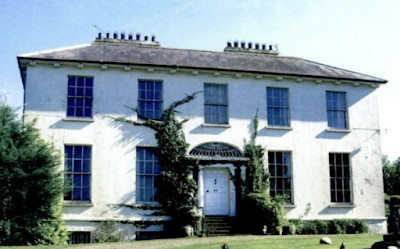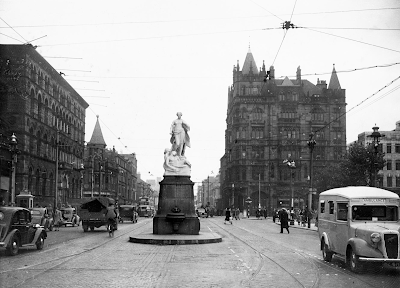IN AUGUST, 2017, I STAYED FOR SEVERAL DAYS ON RATHLIN ISLAND
| Rathlin Manor House in 2017 |
IT MUST be about four years since I last visited Rathlin Island, Northern Ireland's only inhabited off-shore island.
I'm fond of Rathlin.
I have always stayed at the Manor House, former home of Rathlin's landlords, the Gages.
Two ferries - one fast and one slower - sail regularly from the nearest town, Ballycastle in County Antrim.
The fast (passenger-only) ferry takes no more than twenty-five minutes to sail to the island.
My return ticket cost £12.
I arrived at about 10am on Tuesday, checked in early, unpacked and had a brief stroll round Church Bay before a good lunch comprising potato and leek soup in the Manor House, where I stayed for three nights.
| Room Nine |
I actually stayed in Room Nine, a small single room directly above what used to be the snug bar (The Auld Kitchen).
The Manor House closed down a couple of years ago for major renovation work so, subsequently, The Auld Kitchen was not replaced.
The new interior is hard to recognize if you recall the original one: partition walls have been rearranged and fresh, new, contemporary decor - all "mod-cons".
The general colour scheme seems to be painted in a kind of subtle pastel green.
My room had a oculus window and, in fact, there's another oculus window at the opposite end, too.
That evening I enjoyed a good dinner in the main restaurant comprising a lythe (pollack) with whole potatoes and kale; followed by pavlova.
| Lawn in front of the Manor House |
On Wednesday at 8am I had a fine cooked breakfast: two pork sausages, two lean rashers, potato-bread, soda-bread, cherry tomatoes, mushrooms, baked beans, tea and toast.
After breakfast I walked to Soerneog View hostel, where I hired a cycle for the day (£10) and rode westwards to the RSPB Seabird Centre and the West Lighthouse.
The distance from Church Bay to the West Lighthouse is about five miles.
I was rather glad to reach my destination for, although cycling is a good means of seeing the island, the terrain is uneven to the extent that it was easier for me to dismount occasionally and walk up several steep sections.
The benefit, however, is that one can freewheel down!
The RSPB centre looks brand-new and they have a seating area with refreshments for sale.
The West Lighthouse now has an interesting exhibition and most of the keepers' rooms are open.
It cost £400,000 to build in 1912: that is an astounding £42 million in today's money!
Of course it's been fully automatic since the 1980s, I think.
Reinvigorated and fortified with a chilled drink, I mounted the bike and rode back to Church Bay and on towards the southern Rue Lighthouse and lovely Ushet Port.
Ushet was used almost 200 years ago by smugglers; their ruinous building still stands, as does the adjacent coastguard house.
It sounds a bit incongruous, doesn't it? Apparently the smugglers' house used to be a kelp store.
There were over a dozen seals at Ushet warily watching me.
Thence I cycled northwards, towards the East Lighthouse which is closed to the general public.
I left my bike back later in the afternoon.
I was certainly fortunate with the weather, managing to avoid the rain.
| Reception |
The Manor House has a little bar at Reception and this is where I installed myself during the evening before and after dinner.
| Manor House breakfast menu in 2017 |
It's a convivial place where I encountered and struck up conversations with residents and guests.
There's a fine marble fireplace and the fire was lit in the evenings.
On Thursday morning, I opted for the veggie fry (below); thence walked to the National Trust's Ballyconaghan townland.
This walk terminates at a disused 1941 coastguard look-out on the north coast of the island.
En route, one passes a little cluster of cottages, or a clachan, called Crocknanagh.
This consists of four or five old, ruinous cottages forming what would have been a tight-knit community - probably all related in some way or other.
| Ruined cottage at Roonvoolin |
There are many ruined clachans and cottages on Rathlin: its population numbered 1,200 two hundred years ago; whereas today it's closer to 150.
Incidentally, Rathlin's resident population appears to be increasing: today it's closer to 150 and as I write the schoolhouse is being extended.
I was informed that there are now 9 pupils attending the school.
Rathlin still has many traditional, vernacular stone gate-posts.
By the way, I discovered a great little café called The Watershed.
It's located between the Manor House and St Thomas's Church, adjacent to the large vehicle ferry slipway.
They have a small menu and everything is home-made and delicious.
I dined at the Manor House again on Thursday evening: crab cocktail and risotto.
Remember to bring plenty of cash to Rathlin. I was down to my last few banknotes!
Of course most establishments accept credit and debit cards.
There is an ATM machine at McCuaig's Bar which, I think, charges a small fee for the service.
How, on earth, did the islanders cope in the past?
Stuffed it under the mattress, I imagine; or bartered a sheep for a supply of milk!
I think I'll bring along my Swiss hiking boots next time, for although the terrain was mainly dry, some of it was waterlogged.
I had an absolutely terrific time on Rathlin and felt at home in the Manor House, where the crack is good, the company convivial; the staff very hospitable and friendly; and standards high.
First published in August, 2017.
| Margherita pizza & salad at the Watershed Café |
I dined at the Manor House again on Thursday evening: crab cocktail and risotto.
| Crab Cocktail at the Manor House |
Remember to bring plenty of cash to Rathlin. I was down to my last few banknotes!
Of course most establishments accept credit and debit cards.
There is an ATM machine at McCuaig's Bar which, I think, charges a small fee for the service.
How, on earth, did the islanders cope in the past?
Stuffed it under the mattress, I imagine; or bartered a sheep for a supply of milk!
| Dinner menu in 2017 |
I think I'll bring along my Swiss hiking boots next time, for although the terrain was mainly dry, some of it was waterlogged.
I had an absolutely terrific time on Rathlin and felt at home in the Manor House, where the crack is good, the company convivial; the staff very hospitable and friendly; and standards high.
First published in August, 2017.



























